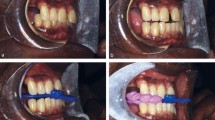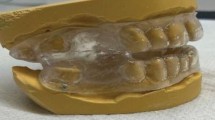Abstract
Data sources Medline was searched for articles dated 1966–July 2003, along with the Cochrane Airways Group Sleep Apnoea Randomised Controlled Trials Register and reference lists of relevant articles.
Study selection Studies were included if they were randomised trials that compared oral appliance (OA) with control or other treatments in adults who had sleep apnoea.
Data extraction and synthesis Trial quality was assessed and two reviewers extracted data independently. Study authors were contacted for missing information.
Results Twelve trials were included, involving 509 participants. All the studies had some methodological shortcomings. Overall, OA use improved the apnoea–hypopnoea index (AHI) more than inactive control. The AHI for the former was −13.17 (95% confidence interval (CI), −18.53 to −7.80) in parallel group data from four studies. Use of an OA reduced daytime sleepiness in two trials, giving a weighted mean difference (WMD) of −1.77 (95% CI, −2.91 to −0.62). OA use was less effective than continuous positive pressure in reducing the AHI (respectively giving a WMD of 13 (95% CI, 7.63−18.36) in parallel studies from two trials and of 6.75 (95% CI, 4.93−8.57) in crossover studies from six trials). No significant difference was observed on symptom scores (data from three trials), however.
Nasal continuous positive airway pressure (nCPAP) was more effective at improving minimum arterial oxygen saturation during sleep compared with OA use. In two small crossover studies, participants preferred OA therapy to nCPAP.
Conclusions There is limited evidence that suggests OA use improves subjective sleepiness and sleep-disordered breathing compared with control. nCPAP is apparently more effective in improving sleep-disordered breathing than OA use. Until there is more definitive evidence on the effectiveness of OA, it is probably appropriate to restrict OA therapy to patients who have sleep apnoea but are unwilling or unable to comply with nCPAP therapy.
Similar content being viewed by others
Commentary
The review on the use of OA for obstructive sleep apnoea states that, although both OA and nCPAP can effectively treat Obstructive Sleep Apnoea and Hypopnoea Syndrome (OSAHS), nCPAP is the most predictable method and would routinely be the preferred choice for clinicians. Nevertheless, a significant clinical consideration is that, whereas nCPAP may be able to ablate apnoeas for virtually all patients, many individuals do not tolerate its use. Thus, OA use can frequently be very effective for people unable or unwilling to adjust to nCPAP. Some patients do not desire, or are incapable of adapting to, regular use of nCPAP because of reasons ranging from discomfort from mask leaks, claustrophobia, travel or even social reasons. This leaves two alternatives: various surgical interventions (eg, uvulopalatopharyngoplasty) with their morbidity, or OA use.
A significant population of people who are intolerant to nCPAP are unwilling to undergo surgery (or who have had surgical failures) but still require treatment. The use of an OA, mostly mandibular advancement devices, is a relatively non-invasive and frequently-effective treatment to use for these otherwise difficult-to-manage cases. Treatment should not be withheld because a person cannot adapt to nCPAP. Papers quoted in the review point out that many patients are adequately managed by OA, and there are instances (even when the device is less effective than nCPAP) when the patient preferred OA to nCPAP.
Anecdotally, I can report on a tertiary medical facility at which OA use became an option. Patients referred to the dental clinic (in this case at a military installation) with OSAHS were solely those who were intolerant of nCPAP, had already experienced failed surgery or were poor risks for surgical therapy. All had pre- and post-operative polysomnography (PSG) and results were tabulated to determine if OA was a viable option. By the end of 18 months the regimen was altered so that all but the most severely affected patients were offered either OA or nCPAP. All had the choice to crossover if they desired, but it was a rare patient who had a satisfactory post-operative PSG after OA use who changed to nCPAP: others participants did the reverse, however.
Some dental practitioners who provide OA are seeing tooth movement in as many as 10% of long-term cases. To a dentist, changes of this nature are major issues but it is extremely difficult to convince a patient to give up their OA. To them, their otherwise untreatable OSAHS symptoms far outweigh the dental complications.
Practice point
-
OA should be the first choice of treatment. There are feasible alternatives for patients who cannot be managed with nCPAP.
Author information
Authors and Affiliations
Additional information
Address for correspondence: Jerome Lim, 2 Eyston Drive, Weybridge, Surrey KT13 0XD, UK. E-mail: jeromelim@doctors.org.uk
Lim J, Lasserson TJ, Fleetham J, Wright J. Oral appliances for obstructive sleep apnoea (Cochrane Review). Cochrane Library 2003; Issue 4. Chichester: John Wiley
Rights and permissions
About this article
Cite this article
Cohen, R. Limited evidence supports use of oral appliances in obstructive sleep apnoea. Evid Based Dent 5, 76 (2004). https://doi.org/10.1038/sj.ebd.6400270
Published:
Issue Date:
DOI: https://doi.org/10.1038/sj.ebd.6400270
This article is cited by
-
Digest
Evidence-Based Dentistry (2006)



